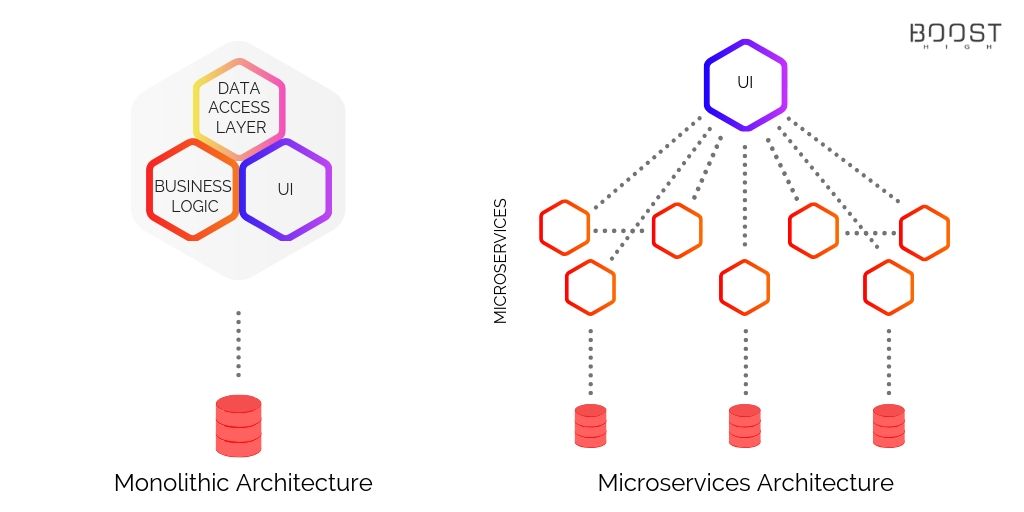Application development often requires from development team a lot of in depth analysis. Especially, when preparing for a big project. It’s a crucial part that influences the end result. One of the biggest factors is the choice of architecture. The most popular dilemma is choosing between monolithic vs. microservices architecture.
Each of them is used in different circumstances so which one to choose?
Applications Architecture – How Does It Effect Your Project?
One of the decisions that has to be made at the beginning of every project is how the business logic and different functionalities will be structured within the application. The behavior of the application that is being determined is called applications architecture. It’s important not to mix it with system architecture! Application architecture focuses on the way in which components are communicating within the application where software architecture is focused on the entire logic behind the structure of the system.
The reason application architecture is so important is that it ensures the ability for the application to scale and work properly over time under different circumstances. The whole purpose is to make the application maximally agile.
But different architectures work best in different projects. There’s no one perfect recipe to make every application as agile as it can be at all times. Some of the most popular application architectures are monolithic architecture and microservices architecture. But which one is the right for your project? Monolithic vs. Microservices – let’s find out.
What is Monolithic Architecture?
Monolithic architecture is considered to be one of a more traditional choices where the whole application is designed into one unified model.
The idea behind this architecture is to interconnect all functionalities and make them codependent. It creates a lot of risk in bigger projects which makes it slowly loose its popularity.
Developing application in monolithic architecture means that every further change and update will require implementing it within the entire system. It can affect certain functionalities and be the reason of application crash. Even small, new functionality added to the application might require developing a whole new version of the application because of its internal connections between modules.
Monolith Pro
- Better for smaller projects that don’t require a lot of computing power
- Easier to develop a MVP in monolithic architecture
- Cheaper and faster development process
Monolith Cons
- The bigger the application is the more difficult supporting is
- Implementing any changes requires a lot of knowledge on the entire application and creates a lot of risk in creating errors
- Performing tests is more time consuming and less efficient
- At some point the application can’t scale up anymore and needs to be rewritten from the beginning or transformed into microservices architecture
- Big application need a lot of computing power and resources located in one place
However, there are also times when it’s the best and only right decision to choose it over microservices architecture.
When To Choose Monolithic Architecture over Microservices Architecture?
Even though, microservices architecture might seem like a good idea, in some cases it’s not. When
First of all, microservices philosophy is to divide the functionalities into separate services that work on different servers. This means that if your application is going to be placed onto 1 server – there’s no point in using microservices architecture. This won’t have the same advantages in this situation.
Moreover, most of the MVPs and prototypes ar based on monolithic architecture because of their high chances of pivoting. Microservices architecture is usually more expensive and requires much more experienced team of developers. Because of these reasons many startups chooses monolithic architecture but stays open to the possibility of rewriting the application on a later stage.
If your time is very limited you might simply not have enough of it to develop an application in microservices architecture. It‘ll take more time and much more experienced developers to deploy this application.
What is Microservices Architecture?
Microservices Architecture has become popular when big, enterprise level applications started becoming more common. Applications like Facebook, Amazon and of course Netflix needed an extremely high ability to scale up very fast and efficiently.
But what it actually is? Microservices architecture is a service-oriented architecture style that divides the application structure into independent services. Each service is responsible for one functionality of the application.
Thanks to this decomposed form of development, each functionality can be placed on a different server and work individually.
Moreover, microservices enable scalability of the application thanks to its modularity. Each microservice is responsible for only one functionality. Because of that, when there’s a need to implement some changes, no other functionality is affected by the change in code like it can happen in monolithic architecture.
Another big advantage of developing application using microservices is the ability to use different technologies in one project. Because these microservices are independent from each other, they can all be developed using different technology. To maximize the performance of certain functionalities we can use C++ but at the same time other microservices can be based on PHP, JavaScript or any other language.
How Does Monolithic vs. Microservices Architecture Work?
As we mentioned earlier, application architecture is a form in which individual components are connected to each other within the app. It’s also about the way they communicate and exchange data.
Different types of architecture are best for different projects. That’s why monolithic vs. microservices architecture is such a popular dilemma when starting a project.
Bellow you can see how both of these architectures work. This simple graphic is going to show you the main difference between monolithic vs. microservices architecture.
As you can see, monolithic architecture forms the application from a mix of codependent modules. On the other hand, microservices seperate each functionality and places them on different servers. This solution maximizes reliability and makes the application run smoother.

Microservices Pros
- Easy scalability thanks to independence of services from each other
- Development is not as complicated if you’ve used microservices before
- Autoscaling allows your application to scale up by itself depending on the load of your app
- Easy support and management thanks to clear modular form of development
- Development team is divided by microservices which makes management easier and development process more clear
- Every microservice can be written using different technology to maximize the performance of the most important functionalities
- Easier update deployment because of lack of dependencies between services
- Faster deployment
Microservices Cons
- Previous experience in microservices is required to deploy proper microservices-based application.
- Development process takes longer
- Developing application in microservices in more expensive than traditional monolithic architecture
When To Choose Microservices Architecture?
Microservices Architecture is mostly used in big projects that need to be optimized in reliability and scalability.
If your project is planned to scale up quickly, you might want to prevent performance issues from happening from the beginning. Microservices will provide the right functioning of the application and auto scaling system will automatically adjust to the load of the app.
Also many application is being rewritten into microservices architecture from monolithic because it stopped working right. That’s why it might be a good choice to consider changing architecture if you have issues with your already existing application.
For example, that’s exactly what Netflix did. Netflix started as a monolithic architecture based application. However, due to rapidly increasing demand, they were facing many performance and reliability issues. In 2009 they decided to move their application to the cloud-based microservices architecture. Dividing their application into hundreds of small microservices allowed them to expand and scale up even more. They’re considered to be one of the first companies to ever use microservices architecture.
Summary
The decision between monolithic vs microservices architecture seems to be fairly easy to make. Microservices architecture is definitely more modern approach used in many big applications. On the other hand monolithic architecture is a traditional form of apps and can be used easily in smaller projects.
If you have any doubts feel free to message us and we’ll give you recommendations.









